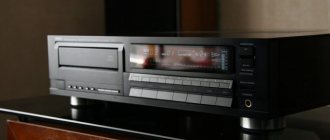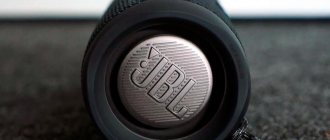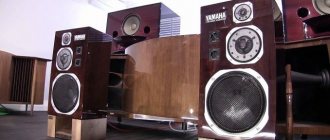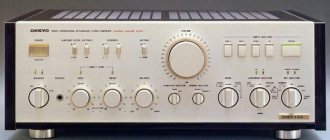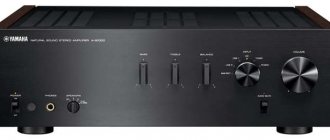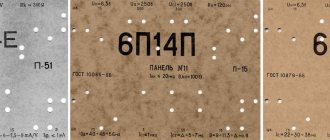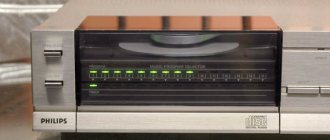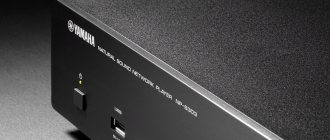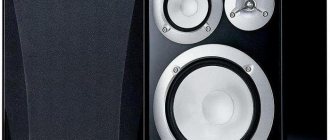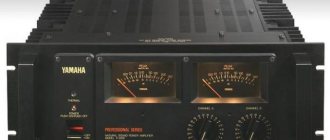| This article need additional quotes for verification . |
Yamaha NS-2000 speaker, front view.
Yamaha NS-2000 loudspeaker, front right top view. Yamaha NS-2000 Speaker, tweeter. Yamaha NS-2000 Speaker, mid-range. Yamaha NS-2000 Speaker, woofer, front view. Yamaha NS-2000 Speaker, cable terminals on the rear panel. Yamaha NS-2000 Speaker, front with cover attached. First released in 1982, Yamaha NS-2000
is an improved version of the older NS-1000 speaker, which was first produced in the early to mid-1970s. Like the NS-1000, it is a 3-way acoustic suspension speaker system with a beryllium dome midrange and tweeter. However, the NS-2000 woofer was completely new, made from pure carbon fiber instead of paper. The body is also improved: it is larger and heavier than the NS-1000.
At the time of its debut, the NS-2000 was Yamaha's flagship speaker system. A few years later, the NSX-10000 was released in limited edition and is very similar to the NS-2000. The NS-2000 was later replaced by the smaller NS-1000x, which has a smaller woofer and similar but different designs of midrange drivers and beryllium dome tweeters. A limited edition walnut veneer version of the NS-1000x, called the NS-1000xw, looks more like the NS-2000 than the standard black NS-1000x. Also of note is Yamaha's line of beryllium domes - this is the later and extremely rare GF-1.
Woofer
The woofer is made from pure, long carbon fibers that have been manufactured into sheets. Eight sheets are glued together to form a cone. The dust cap in the center is also a carbon fiber sheet formed into a dome. The woofer magnet is 11350 Gauss and 220,000 Maxwell. The frame is cast aluminum.
The original rolled woofer surround was made of polyurethane and designed for optimal sound. However, on NS-2000 speakers it was often brittle and worn out. Fortunately, edge replacement can be done by speaker repair shops, and the woofer can continue to function normally.
Frequency Response The woofer is rated down to 28Hz, making the NS-2000 a full-range speaker that does not require a separate subwoofer for low frequencies. The crossover starts at 500 Hz.
The specifications indicate that the woofer diameter is 33 cm (13 inches). This is 13 inches when measured between the outer edges of the die-cast aluminum frame. The inside diameter of the frame, including the diffuser and foam surround, is approximately 12 inches. .
Mid range
The mid-frequency dome has a diameter of 8.8 cm (3.5 in) and is made of beryllium metal, a very strong metal with a very low density (1.8 g/cm3), obtained by vapor deposition of the metal onto the dome shape. As a result, the midrange dome is very The dome lining is made of fabric coated with two types of resins and folded to form folds tangent to the dome. This design holds the canopy securely, but allows the canopy to move precisely.
The midrange dome is covered with a wire protective mesh. The dome is also partially covered by a ring. The ring is designed to act as an audio diffuser to improve sound dispersion and stereo imaging, but it also helps protect the dome. Some NS-1000 and NS-2000 owners have experimented with removing the wire mesh and cone to hear the difference, but leave the dome alone. The NS-2000 has a fabric cover, and for some audio engineers it is important to at least remove the cover (for example, muffled conversation sound through a T-shirt or not).
The mid-range operates at frequencies from 500 Hz to 6 kHz. Magnet - 18,400 Gauss and 150,000 Maxwell. The frame is made of die-cast aluminum.
If the power consumption is exceeded or the dome is faulty, the dome may crack or break into pieces. If this happens, particles of beryllium metal may become airborne. Beryllium particles in the lungs and body are toxic and carcinogenic. Do not inhale anything from the dome.
The midrange level control can be turned to adjust the level between +2 to infinity (no sound). The tweeter has a similar level adjustment. Some NS-1000 and NS-2000 owners have modified their speaker to bypass these level controls, which could add distortion. The improved NSX-10000 speaker does not have these level controls.
New breath Yamaha NS-5000
Yamaha is a very serious player and trendsetter in the field of High Fidelity. In 1973, their audiophile amplifier Yamaha CA-1000 revolutionized people's understanding of what high-quality sound is.
Yamaha CA-1000 (1973)
In amplification, Yamaha was very good, gushing with wonderful audio cars - Yamaha B-2, Yamaha A-2000, Yamaha MX-2000, Yamaha MX-10000, etc.
Yamaha MX-10000
In the speaker industry, Yamaha has launched one of the most desirable models, the Yamaha NS-1000 and NS-2000.
Yamaha NS-2000
Also widely less known, mainly due to their rather hefty prices and fewer owners, are the more stunning Yamaha FX-1 and Yamaha FX-3 speakers.
Yamaha FX-3
I am not familiar with the modern Soavo series, and I cannot judge the quality of their sound, but it is obvious that the fleeting fashion for bollards also affected Yamaha.
Yamaha Soavo
At the end of the 90s, all companies, due to the boom in home theaters, made a break from reality by jumping into pole building - everyone was guilty of this - Diatone, Onkyo and, accordingly, Yamaha. But the time of boundless frenzy is coming to an end and sensible thoughts and the desire to make high-quality sounding acoustics arise again, so everything is systematically returning to normal, that is, away from the design pillars to the Yamaha NS-1000/Diatone DS-77/S-90 form factor .
Onkyo probably acted wiser during this period of time; instead of placing pillars, Onkyo focused on good-sounding bookshelf speakers, releasing the Onkyo D-302e, Onkyo D-412EX and simpler models 312,212,112.
Onkyo D-412EX
But the desire to release a full-fledged acoustic system did not leave the company and in 2015 Onkyo returned to normal form factor acoustic systems, reviving its famous mid-level acoustics Onkyo D-77NE and assigning it, in today's realities of pillar construction, the price at which they sound compared to competitors - 360,000 rubles ($6000).
Onkyo D-77NE (2015)
Swallowed a sudden lump in your throat? Similarly, other giants also returned the form factor to adequacy by starting to produce JBL 4312E, etc.
JBL 4312E
Yamaha did not stand aside while developing new high-end speaker systems Yamaha NS-5000 and demonstrated them in 2015.
Yamaha was also not modest about the price for good sound after the columns - 1 million 500 thousand yen.
The Yamaha NS-5000 is not a replica of previous models, but truly a newly designed speaker system. All 3 new speakers use a new material solution.
In appearance, it seems that the speakers look like metal ones, but this is both not true and true. For the speaker membrane, a modification of the zylon material is used, 1.5 mm threads of which can withstand weight up to 920 kg (this is stronger than Kevlar). In dynamics, the threads are thinner, they are also reinforced with gold threads, and a copper-nickel alloy is sprayed on top of the fabric.
Zylon fabric is actually widely known; it is from it that firefighter clothing is made, which can withstand truly hellish temperatures (650°). For the speaker, the threads were thinned to give them more softness. The dimensions of the speaker cones are finally of normal size: LF - 30 cm MF - 8 cm HF 2.5 cm
The front panel of the speaker systems is 29.5 mm thick. The weight of one speaker is 35 kg, and the size is: 395 × 381 × 690 mm (W × D × H).
Not only our foreign colleagues had the opportunity to listen to these acoustic systems, but also at the Hi-End show in Moscow that ended yesterday. And for those who have not attended it, I offer a selection of videos from Youtube to get an idea of the class of sound.
Demonstration of Yamaha NS-5000 in Japan (Osaka, 2016)
Demonstration of Yamaha NS-5000 at MHES 2016
Killer combo Yamaha A-S3000 + Yamaha cd-S3000 + Yamaha NS-5000
It is certainly encouraging that manufacturers of Hi-Fi and Hi-End components have finally thrown off the veil of cinematic intoxication and are once again gaining shape in the field of audiophile high-precision sound.
Cabinet
The cabinet is a work of woodcraft and acoustic engineering. Computer modal analysis was used in the design to avoid excessive resonance and achieve a well-balanced cabinet modal response.
The result of engineering is a cabinet with rounded corners cut from solid wood. beech tree. Most of the rest of the body is made of thick, high-density material. Chipboard. American walnut veneer. Inside the cabinet there are additional braces in all corners and in a few other places. The housing is filled with acoustic damping material. The speaker is acoustically suspended, so the entire body is sealed. The total weight of the NS-2000 speaker is 47 kg (103 lb 6 oz) and dimensions are 440 x 752 x 404 mm (17-5/8 in x29-5/8 in x15-7/8 in).
Yamaha A-S2000
Guest, 07/18/2013
Pros: Playback quality. Constructive. Design. Price-quality ratio. High quality phono preamplifier and good headphone amplifier. Decent noise immunity (despite the terrible quality of electricity in my sockets and a fairly developed audio/video system).
Disadvantages: Perhaps excessive sensitivity to the characteristics and organization of switching (obviously reacts even to the polarity of the power plug and changing cables). That is, in order to extract all the potential inherent in it from the Yamaha A-S2000, you need to work hard (experiment and, perhaps, spend additional money on a surge protector and a voltage stabilizer with an output of 230~240 V). The output from the preamplifier is mediocre (the result of connecting an active subwoofer was deeply disappointing), and for high levels (to the speaker outputs), the manufacturer does not recommend connecting an active subwoofer. Apparently, due to the peculiarities of the circuitry, two-wire connection of acoustics (bi-wiring) is also not one of the main connection methods, but only a marketing ploy - the sound becomes somehow blurry, emotionless and flat (I connected it with two pairs of cables to each terminal of the amplifier and speakers), but it is possible that the problem is in the acoustics (JBL 4319). Relatively narrow input voltage range (maximum 2.8 Volts), for this reason it was necessary to activate the pre-amplifier function and reduce the output level on the source (AUDIOLAB 8200CDQ), since it has an output of 4.1 Volts with the pre-amplifier disabled, otherwise distortion becomes audible due to overload.
Comment: About the nature of the sound of the Yamaha A-S2000: it seemed to me that it can turn an audiophile into a music lover, that is, when listening to music, you forget about analyzing it, breaking it down into its components. The musical picture seems whole and indivisible, emotions will prevail over the study and contemplation of individual sounds. Therefore, even difficult-to-understand music becomes easy to understand and enjoy. Well, if you still try to evaluate the sound of the Yamaha A-S2000 according to audiophile criteria, then here is my summary: The bass is plentiful, voluminous, very deep, but not oppressive (on some recordings you sometimes get the feeling that not a lady with a dog lives on the floor below, but two hefty weightlifters who love to hit their ceiling with the heaviest Olympic bars to the beat of my music). The middle is melodious, beautiful, harmonious. The highs are bright in a good way, but not hard, not loud or accentuated (Yamaha, of course, does not cancel the dependence on the quality and characteristics of the recording). The general character of the sound is smooth, sort of intelligent and combed or something. Neat and pedantic in general, but by no means overly reserved and prim. There is coloration, it is not super transparent and sterile, but these interpretations do not catch the ears. I highly recommend it, but not to everyone, and primarily to experienced music lovers and audiophiles who have experienced more than one modification of their system, because in order for the Yamaha A-S2000 to reveal its “soul,” a certain bank of knowledge and skills is needed. So, once you listen to the Yamaha A-S2000, don’t rush to conclusions right away. The amplifier is actually excellent, just demanding on the environment, however, like any high-quality audio equipment.
Characteristics
- Type: Three-way acoustic suspension
- Woofer: 33 cm (13 in) pure carbon fiber cone
- Mids: 8.8 cm (3 1/2 in) pure beryllium dome
- Tweeter: 3 cm (1 3/16 in) diameter pure beryllium dome
- Music input power: 250W
- Rated input power: 125W
- Sound pressure level: 90 dB/W/m
- Nominal impedance: 6 ohms
- Frequency range: 28 Hz to 20000 Hz
- Crossover frequencies: 500 Hz, 6 kHz (-12 dB/oct.)
- Mid Level Control: ±3 dB continuous
- Tweeter Level Adjustment: ±3dB continuous
- Dimensions (W × H × D): 440 × 752 × 404 mm (17 5/8 × 29 5/8 × 15 7/8 inches)
- Weight: 47 kg / each [1]
